Yamaha CLP-154S, CLP-155 User Manual
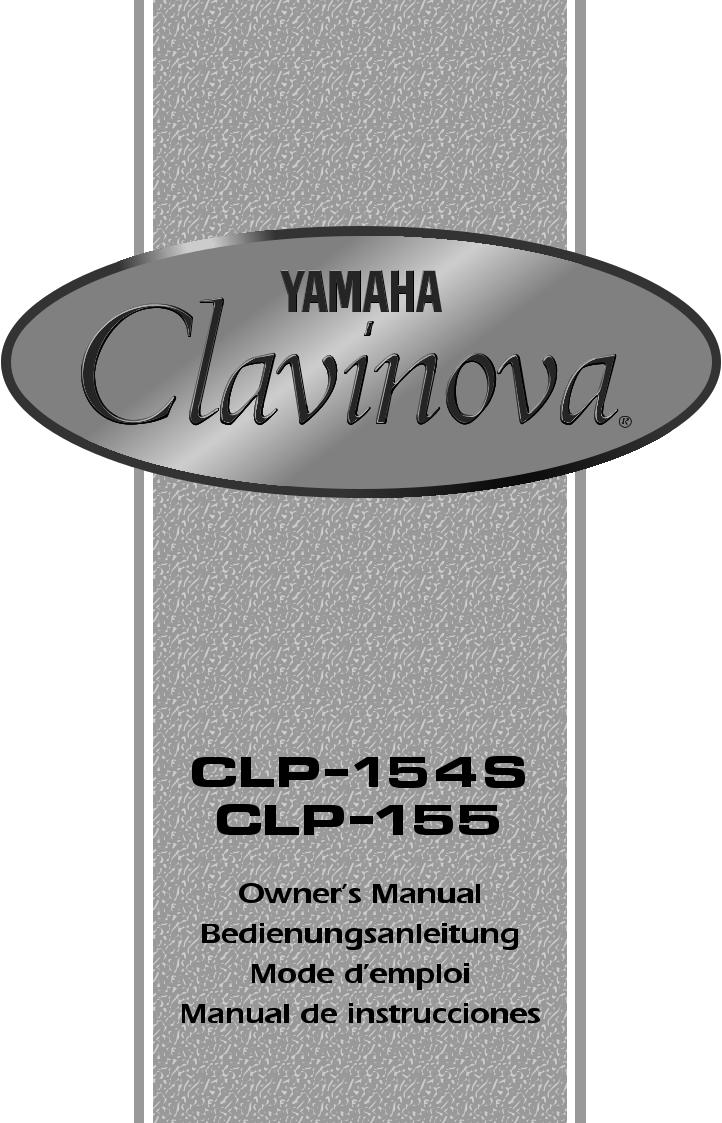
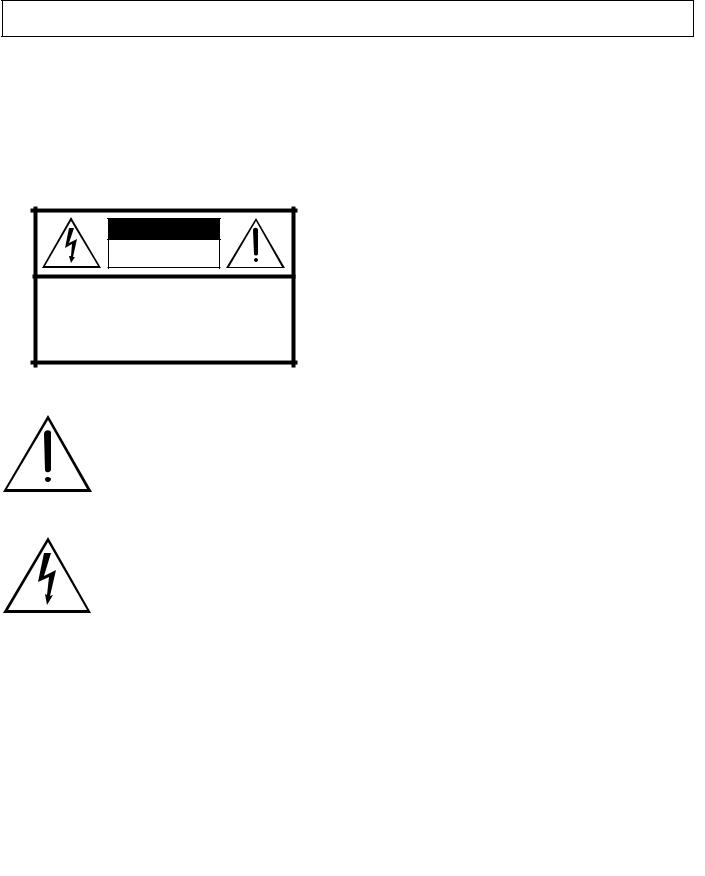
SPECIAL MESSAGE SECTION
PRODUCT SAFETY MARKINGS: Yamaha electronic products may have either labels similar to the graphics shown below or molded/stamped facsimiles of these graphics on the enclosure. The explanation of these graphics appears on this page. Please observe all cautions indicated on this page and those indicated in the safety instruction section.
CAUTION |
RISK OF ELECTRIC SHOCK |
DO NOT OPEN |
CAUTION: TO REDUCE THE RISK OF ELECTRIC SHOCK. |
DO NOT REMOVE COVER (OR BACK). |
NO USER-SERVICEABLE PARTS INSIDE. |
REFER SERVICING TO QUALIFIED SERVICE PERSONNEL. |
See bottom of Keyboard enclosure for graphic symbol markings
The exclamation point within the equilateral triangle is intended to alert the user to the presence of important operating and maintenance (servicing) instructions in the literature accompanying the product.
The lightning flash with arrowhead symbol, within the equilateral triangle, is intended to alert the user to the presence of uninsulated “dangerous voltage” within the product’s enclosure that may be of sufficient magnitude to constitute a risk of electrical shock.
IMPORTANT NOTICE: All Yamaha electronic products are tested and approved by an independent safety testing laboratory in order that you may be sure that when it is properly installed and used in its normal and customary manner, all foreseeable risks have been eliminated. DO NOT modify this unit or commission others to do so unless specifically authorized by Yamaha. Product performance and/or safety standards may be diminished. Claims filed under the expressed warranty may be denied if the unit is/has been modified. Implied warranties may also be affected.
SPECIFICATIONS SUBJECT TO CHANGE: The information contained in this manual is believed to be correct at the time of printing. However, Yamaha reserves the right to change or modify any of the specifications without notice or obligation to update existing units.
ENVIRONMENTAL ISSUES: Yamaha strives to produce products that are both user safe and environmentally friendly. We sincerely believe that our products and the production methods used to produce them, meet these goals. In keeping with both the letter and the spirit of the law, we want you to be aware of the following:
Battery Notice: This product MAY contain a small nonrechargable battery which (if applicable) is soldered in place. The average life span of this type of battery is approximately five years. When replacement becomes necessary, contact a qualified service representative to perform the replacement.
Warning: Do not attempt to recharge, disassemble, or incinerate this type of battery. Keep all batteries away from children. Dispose of used batteries promptly and as regulated by applicable laws. Note: In some areas, the servicer is required by law to return the defective parts. However, you do have the option of having the servicer dispose of these parts for you.
Disposal Notice: Should this product become damaged beyond repair, or for some reason its useful life is considered to be at an end, please observe all local, state, and federal regulations that relate to the disposal of products that contain lead, batteries, plastics, etc.
NOTICE: Service charges incurred due to lack of knowledge relating to how a function or effect works (when the unit is operating as designed) are not covered by the manufacturer’s warranty, and are therefore the owners responsibility. Please study this manual carefully and consult your dealer before requesting service.
NAME PLATE LOCATION: The graphic below indicates the location of the name plate. The model number, serial number, power requirements, etc., are located on this plate. You should record the model number, serial number, and the date of purchase in the spaces provided below and retain this manual as a permanent record of your purchase.
CLP-155 |
CLP-154S |
Model _____________________________________
Serial No. __________________________________
Purchase Date ______________________________
92-469 1

Introduction
Thank you for choosing a Yamaha CLP-154S/155 Clavinova. Your Clavinova is a fine musical instrument that employs advanced Yamaha music technology. With the proper care, your Clavinova will give you many years of musical pleasure.
●Yamaha’s AWM (Advanced Wave Memory) tone generator system offers rich, realistic voices. The CLP-155 additionally features stereo sampling of its PIANO 1 voice for unmatched realism and expressive power.
●Piano-like touch response — adjustable in 4 stages — provides extensive expressive control and outstanding playability.
●Dual play mode allows 2 voices to be played simultaneously.
●Unique Clavinova Tone voice provides a fresh sound for new musical expression.
●Damper pedal includes natural resonance effect for the piano voices, simulates the string and soundboard resonance of acoustic pianos.
●Metronome feature with variable tempo facilitates practice.
●2-track digital recorder lets you record and play back anything you play on the keyboard (up to approximately 4,200 notes).
●MIDI compatibility and a range of MIDI functions make the Clavinova useful in a range of advanced MIDI music systems.
In order to make the most of your Clavinova’s performance potential and features, we urge you to read this Owner’s Manual thoroughly, and keep it in a safe place for later reference.
Taking Care Of Your Clavinova
Your Clavinova is a fine musical instrument, and deserves the most careful treatment. Observe the following points and your Clavinova will sound and look great for many years.
1Never open the case and touch or tamper with the internal circuitry.
2Always turn the POWER switch OFF after use, and close the key cover to protect the keyboard, or cover the keyboard with the dust cover provided.
3Clean the cabinet and keys of your Clavinova only with a clean, slightly damp cloth. A neutral cleanser may be used if desired. Never use abrasive cleansers, waxes, solvents or chemical dust cloths since these can dull or damage the finish.
4Never place any vinyl products on your Clavinova. Contact with vinyl can cause irreversible damage to the finish.
5Install your Clavinova in a place that is away from direct sunlight, excessive humidity or heat.
6Never apply excessive force to the controls, connectors or other parts of your Clavinova, and avoid scratching or bumping it with hard objects.
●Name Plate Location
The CLP-154S/155 name plate is located on the bottom panel.

Contents
The Control Panel ............................................................ |
2 |
Connections ...................................................................... |
4 |
Selecting & Playing Voices ........................................... |
5 |
■ Playing the Demonstration Tunes ............................... |
6 |
The Dual Mode .................................................................. |
7 |
● Adjusting the Balance Between the |
|
Dual-mode Voices .................................................. |
7 |
● Shifting a Dual-Mode Voice Up One Octave .......... |
7 |
● Slow-attack Strings (CLP-155 only) ....................... |
7 |
● Memorizing the Balance, Strings Type (CLP-155), |
|
& Octave Shift Settings .......................................... |
7 |
Reverb ............................................................................... |
8 |
● Adjusting Reverb Depth ......................................... |
8 |
● Memorizing the Reverb Type & Depth Settings ..... |
8 |
Brilliance (CLP-155) .......................................................... |
9 |
● Memorizing the Brilliance Setting ........................... |
9 |
The Pedals ......................................................................... |
9 |
● Soft (Left) Pedal ..................................................... |
9 |
● Sostenuto (Center) Pedal ....................................... |
9 |
● Damper (Right) Pedal ............................................. |
9 |
Touch Sensitivity ........................................................... |
10 |
● Memorizing the Touch Sensitivity Setting ............ |
10 |
Transposition .................................................................. |
10 |
Pitch Control ................................................................... |
11 |
● Tuning Up ............................................................. |
11 |
● Tuning Down ........................................................ |
11 |
● To Restore Standard Pitch ................................... |
11 |
● Memorizing the Pitch Control Setting ................... |
11 |
The Metronome & Tempo Control ............................. |
12 |
■ The Metronome ........................................................ |
12 |
● Metronome Volume .............................................. |
12 |
● Metronome Time Signature .................................. |
12 |
■ Tempo Control .......................................................... |
12 |
Using the Recorder ....................................................... |
13 |
■ Recording .................................................................. |
13 |
● Changing the Initial Settings ................................. |
14 |
● Erasing a Single Track ......................................... |
14 |
■ Playback ................................................................... |
14 |
● Fast Forward Playback ......................................... |
14 |
MIDI Functions ............................................................... |
15 |
● A Brief Introduction to MIDI .................................. |
15 |
● MIDI “Messages” Transmitted & Received |
|
by the Clavinova ................................................... |
15 |
● MIDI Transmit & Receive Channel Selection ....... |
16 |
● MIDI Transmit Transpose ..................................... |
16 |
■ Other MIDI Functions ................................................ |
17 |
● Local Control ON/OFF .......................................... |
17 |
● Program Change ON/OFF ................................... |
17 |
● Control Change ON/OFF ...................................... |
18 |
● The Multi-Timbre Mode ........................................ |
18 |
● The MIDI Split & Left Local OFF Mode ................ |
19 |
● The MIDI Split & Right Local Off Mode ................ |
19 |
● Transmitting the Panel Settings (CLP-155 only) .. |
20 |
● Bulk Data Dump ................................................... |
20 |
Factory Preset Recall ................................................... |
21 |
Troubleshooting ............................................................. |
21 |
Options & Expander Modules .................................... |
21 |
Keyboard Stand Assembly |
............................................ i |
MIDI Data Format ........................................................... |
vii |
Specifications ................................................................ |
viii |
MIDI Implementation Chart .......................................... |
ix |
1
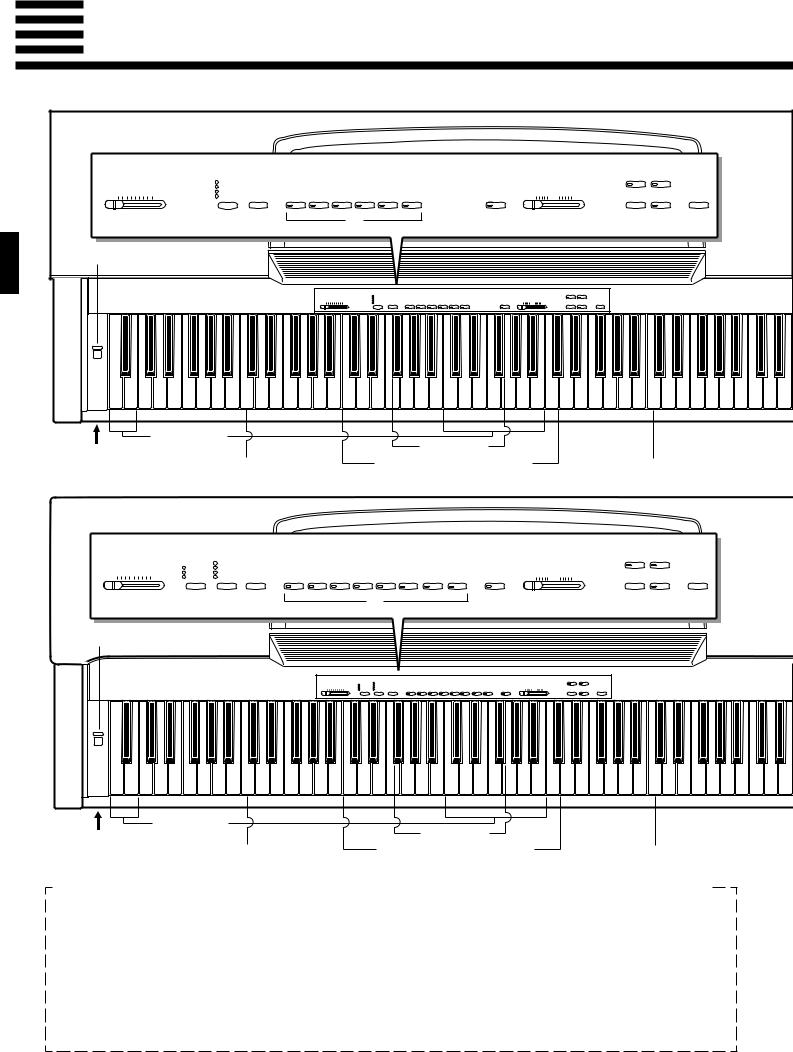
The Control Panel
CLP-154S |
|
|
|
|
|
|
|
|
|
|
|
|
|
|
|
|
|
|
|
|
|
|
|
|
|
|
|
|
|
|
RECORDER |
|
|
|
|
REVERB |
|
|
|
|
|
|
|
|
|
|
|
1 |
2 |
|
|
|
ROOM |
|
|
|
|
|
|
|
|
|
|
|
|
|
|
|
|
HALL 1 |
|
|
|
|
|
|
|
|
|
|
|
|
|
|
|
MASTER VOLUME |
HALL 2 |
MIDI/ |
|
|
CLAVINOVA |
HARPSI- |
|
|
|
TEMPO |
|
|
|
|
|
MIN |
MAX |
COSMIC |
TRANSPOSE |
PIANO 1 |
PIANO 2 |
TONE |
E. PIANO |
CHORD |
ORGAN |
METRONOME |
32 |
120 |
280 |
PLAY |
REC |
DEMO |
|
2 |
4 |
5 |
|
|
|
6 |
|
|
7 |
|
8 |
|
|
9 |
0 |
1 |
|
|
|
|
|
|
|
|
|
|
|
|
|
|
|
|
|
|
|
|
|
|
|
|
|
|
|
|
|
RECORDER |
|
|
|
|
|
|
|
|
|
|
|
REVERB |
|
|
|
1 |
|
2 |
|
|
|
|
ROOM |
|
|
|
|
|
|
|
|
|
|
|
|
|
|
|
HALL 1 |
|
|
|
|
|
|
|
|
|
|
|
|
|
|
MASTER VOLUME |
HALL 2 |
MIDI/ |
|
CLAVINOVA |
|
HARPSI- |
|
|
|
TEMPO |
|
|
|
|
MIN |
MAX |
COSMIC |
TRANSPOSE |
PIANO 1 PIANO 2 |
TONE |
E. PIANO |
CHORD |
ORGAN |
METRONOME |
32 |
120 |
280 |
PLAY |
REC |
DEMO |
POWER
A-1 B-1 C0 D0 E0 F0 G0 A0 B0 C1 D1 E1 F1 G1 A1 B1 C2 D2 E2 F2 G2 A2 B2 C3 D3 E3 F3 G3 A3 B3 C4 D4 E4 F4 G4 A4 B4 C5 D5 E5 F5 G5 A5 B5 C6 D6 E6
|
Pitch control keys |
|
|
PHONES Jacks |
(See page 11) |
Transpose keys |
|
|
(See page 10) |
|
|
(Bottom Panel) |
Left voice shift up key |
Balance/Depth keys (See page 7, 8) |
Right voice shift up key |
|
(See page 7) |
|
(See page 7) |
CLP-155
|
|
BRILLIANCE |
REVERB |
|
|
|
|
|
|
|
|
|
|
|
|
|
|
|
RECORDER |
|
|
|
|
|
|
|
|
|
|
|
|
|
|
|
|
|
|
|
1 |
2 |
|
||
|
|
|
ROOM |
|
|
|
|
|
|
|
|
|
|
|
|
|
|
|
|
|
|
|
|
MELLOW |
HALL 1 |
|
|
|
|
|
|
|
|
|
|
|
|
|
|
|
|
|
|
|
MASTER VOLUME |
NORMAL |
HALL 2 |
MIDI/ |
|
CLAVINOVA |
|
HARPSI- |
|
|
|
|
|
|
TEMPO |
|
|
|
|
|
|
MIN |
MAX |
BRIGHT |
COSMIC |
TRANSPOSE |
PIANO 1 PIANO 2 |
TONE |
E. PIANO |
CHORD |
VIBES |
STRINGS |
ORGAN |
METRONOME |
32 |
120 |
280 |
|
PLAY |
REC |
DEMO |
||
|
2 |
3 |
4 |
5 |
|
|
6 |
|
|
|
|
7 |
|
8 |
|
|
|
9 |
0 |
||
1 |
|
|
|
|
|
|
|
|
|
|
|
|
|
|
|
|
|
|
|
|
|
|
|
|
|
|
|
|
BRILLIANCE |
REVERB |
|
|
|
|
|
|
|
|
RECORDER |
|
|
|
|
|
|
|
|
|
|
|
|
|
|
|
|
|
|
|
1 |
2 |
|
|
|
||
|
|
|
|
|
|
|
|
ROOM |
|
|
|
|
|
|
|
|
|
|
|
|
|
|
|
|
|
|
|
|
MELLOW |
HALL 1 |
|
|
|
|
|
|
|
|
|
|
|
|
|
|
|
|
|
|
|
MASTER VOLUME |
NORMAL |
HALL 2 |
MIDI/ |
|
CLAVINOVA |
HARPSI- |
|
|
TEMPO |
|
|
|
|
|
|
|
|
|
|
|
MIN |
MAX |
BRIGHT |
COSMIC |
TRANSPOSE |
PIANO 1 |
PIANO 2 TONE E. PIANO |
CHORD VIBES |
STRINGS ORGAN |
METRONOME |
32 120 |
280 |
PLAY |
REC |
DEMO |
|
|
POWER
A-1 B-1 C0 D0 E0 F0 G0 A0 B0 C1 D1 E1 F1 G1 A1 B1 C2 D2 E2 F2 G2 A2 B2 C3 D3 E3 F3 G3 A3 B3 C4 D4 E4 F4 G4 A4 B4 C5 D5 E5 F5 G5 A5 B5 C6 D6 E6
|
|
|
|
|
|
|
|
|
|
Pitch control keys |
|
|
|
|
|
|
|
|
|
|
|
|
|
|
|
|
|
|
|
|
|
|
|
|
|
|
|
|
|
|
|
|
|
|
|
|
|
|
|
|
|
|
|
|
|
|
||||||||||||||||
PHONES Jacks |
|
|
(See page 11) |
|
|
|
|
|
|
|
|
|
|
|
|
|
Transpose keys |
|
|
|
|
|
|
|
|
|
|
|
|
|
|
|
|
|
|
|
|
|||||||||||||||||||||||||||||||||||
|
|
|
|
|
|
|
|
|
|
|
|
|
|
|
|
|
|
|
|
|
|
|
|
|
|
|
|
|
|
|
|
(See page 10) |
|
|
|
|
|
|
|
|
|
|
|
|
|
|
|
|
|
|
|
|
||||||||||||||||||||
|
(Bottom Panel) |
|
|
|
|
|
|
|
Left voice shift up key |
|
|
|
|
|
|
|
|
|
Balance/Depth keys (See page 7, 8) |
|
|
|
|
|
|
|
|
|
Right voice shift up key |
|||||||||||||||||||||||||||||||||||||||||||
|
|
|
|
|
|
|
|
|
|
|
|
|
|
|
|
|
|
(See page 7) |
|
|
|
|
|
|
|
|
|
|
|
|
|
|
|
|
|
|
|
|
|
|
|
|
|
|
|
|
|
|
|
|
|
|
|
|
|
(See page 7) |
||||||||||||||||
|
|
|
|
|
|
|
|
|
|
|
|
|
|
|
|
|
|
|
|
|
|
|
|
|
|
|
|
|
|
|
|
|
|
|
|
|
|
|
|
|
|
|
|
|
|
|
|
|
|
|
|
|
|
|
|
|
|
|
|
|
|
|
|
|
|
|
|
|
|
|
|
|
● The Music Stand
If you will be using sheet music with your Clavinova, raise the music stand built into its top panel by lifting the rear edge of the music stand, then flip down the music stand braces and engage them with the corresponding recesses.
The music stand can be lowered after slightly lifting it and folding the two brackets which support it against the back of the stand.
2
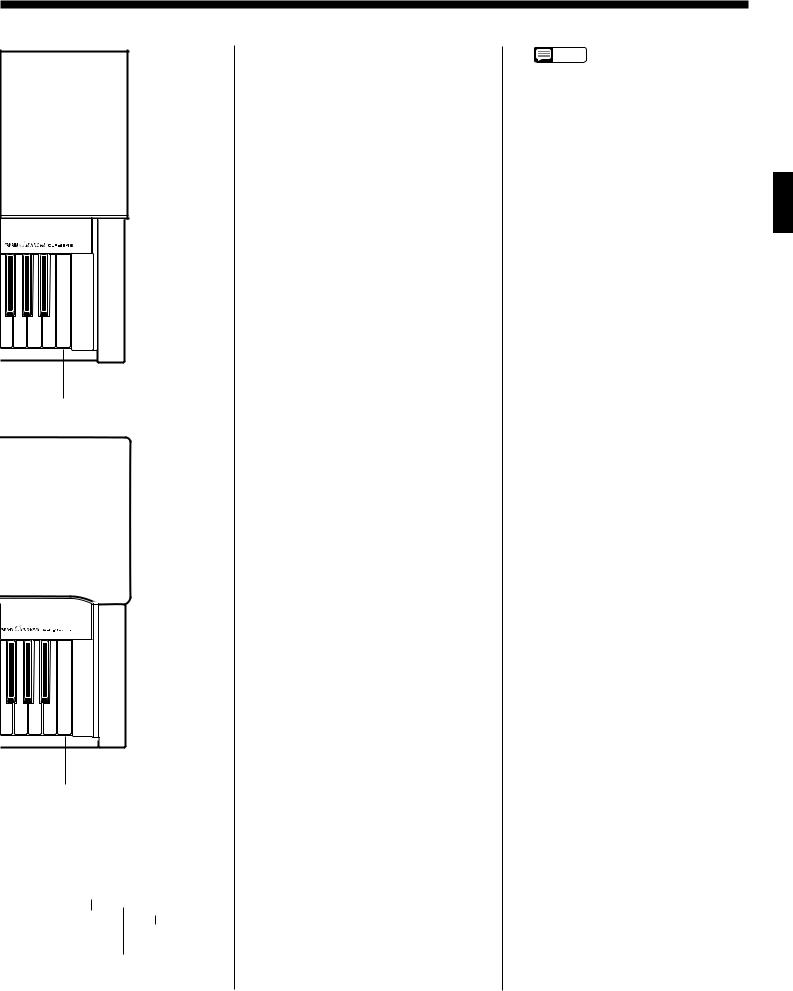
F6 G6 A6 B6 C7
Memory key
(See page 7, 8, 10, 11)
F6 G6 A6 B6 C7
Memory key
(See page 7, 8, 10, 11)
!
Soft
pedal Damper pedal
Sostenuto
pedal
1[POWER] Switch
Press the [POWER] switch once to turn the power ON, a second time to turn the power OFF. When the power is initially turned ON, the [PIANO 1] voice selector LED will light, and the power indicator located below the left end of the keyboard will light.
2[MASTER VOLUME] Control
The [MASTER VOLUME] control adjusts the volume (level) of sound produced by the Clavinova’s internal stereo sound system. The [MASTER VOLUME] control also adjusts headphone volume when a pair of headphones is plugged into the PHONES jack (page 4).
3[BRILLIANCE] Button (CLP-155 only)
This button can be used to change the tonality or “timbre” of the selected voice. See page 9 for details.
4[REVERB] Button
The [REVERB] button selects a number of digital reverb effects that you can use for extra depth and expressive power. See page 8 for details.
5[MIDI/TRANSPOSE] Button
The [MIDI/TRANSPOSE] button allows access to the Clavinova’s TRANSPOSE function (to shift the pitch of the entire keyboard up or down), keyboard touch sensitivity adjustment, and MIDI functions. For details refer to “TRANSPOSITION” on page 10, “TOUCH SENSITIVITY” on page 10, and “MIDI FUNCTIONS” on page 15.
6Voice Selectors
The CLP-154S has six voice selectors and the CLP-155 has eight. Simply press any of the voice selectors to select the corresponding voice. The voice selector LED will light to indicate which voice is currently selected. The CLP-154S/155 also has a DUAL mode in which two voices can be played simultaneously across the full range of the keyboard — see page 7
for details.
NOTE |
• The PIANO 1 voice is auto- |
|
matically selected whenever |
||
|
||
|
the [POWER] switch is ini- |
|
|
tially turned ON. |
7[METRONOME] Button
Turns the metronome sound on and off. The [TEMPO] control, below, is used to set the tempo of the metronome sound. More precise tempo settings can be achieved by using the [METRONOME] button and the CLP-154S/155 keyboard as described on page 12.
8[TEMPO] Control
This control adjusts the tempo of the CLP-154S/155 metronome function as well as the playback tempo of the recorder function. The tempo range is from 32 to 280 quarter-note beats per minute.
9RECORDER [PLAY] and [REC] Buttons
These buttons control the CLP-154S/ 155 2-track recorder, letting you record and play back just about anything you play on the keyboard — up to a maximum of about 4,200 notes. See page 13 for details.
0[DEMO] Button
Activates the demo playback mode in which you can select playback of different demonstration sequences for each of the Clavinova’s voices. See page 6 for details.
!Pedals
The CLP-154S/155’s soft (left), sostenuto (center) and damper (right) pedals provide a range of expressive control capabilities similar to the pedal functions on an acoustic piano. See page 9 for details.
3
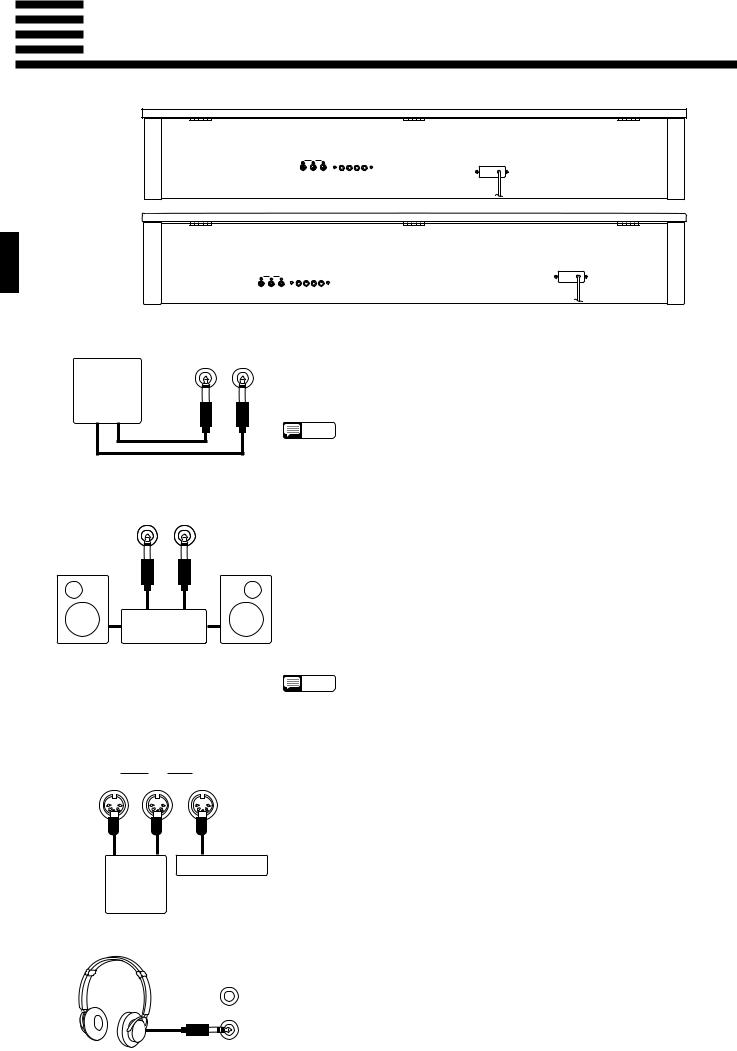
Connections
CLP-154S
3 12
MIDI
IN |
OUT |
THRU |
AUX IN |
AUX OUT |
|
|
|
R |
L |
R |
L/L+R |
CLP-155
312
MIDI
IN |
OUT |
THRU |
AUX IN |
AUX OUT |
|
|
|
R |
L |
R |
L/L+R |
1 AUX IN L and R Jacks
AUX IN
R L
DOU-10
2 AUX OUT L/L+R and R Jacks
AUX OUT
R L/L+R
These jacks are intended for use with an external tone generator module such as the Yamaha DOU-10 Disk Orchestra Unit. The stereo outputs from the external tone generator module are connected to the AUX IN L and R jacks, allowing the sound of the tone generator to be reproduced via the Clavinova’s internal sound system and speakers.
NOTE |
• The input signal from the AUX IN jacks is delivered to the AUX OUT jacks, but is |
|
not affected by the Clavinova’s volume control or reverb effect. |
||
|
The AUX OUT L/L+R and R jacks deliver the output of the Clavinova for connection to an instrument amplifier, mixing console, PA system, or recording equipment. If you will be connecting the Clavinova to a monaural sound system, use only the L/L+R jack. When a plug is inserted into the L/L+R jack only, the leftand right-channel signals are combined and delivered via the L/L+R jack so you don’t lose any of the Clavinova’s sound.
The Internal Amplifier & Speaker System
The CLP-154S and CLP-155 feature high-performance stereo amplifiers delivering 20 and Stereo System 30 watts per channel, respectively. The CLP-155 features a bass-reflex type enclosure with
two 13-cm and two 5-cm speakers, while the CLP-154S houses a pair of 13-cm speaker units in a sealed enclosure.
NOTE |
• The AUX OUT jack signal must never be returned to the AUX IN jacks, either |
|
directly or through external equipment. |
||
|
3MIDI IN, THRU and OUT Connectors
|
MIDI |
|
IN |
OUT |
THRU |
Tone Generator
DOU-10
● PHONES Jacks (Bottom Panel)
The MIDI IN connector receives MIDI data from an external MIDI device (such as the DOU-10 Disk Orchestra Unit) which can be used to control the Clavinova. The MIDI THRU connector re-transmits any data received at the MIDI IN connector, allowing “chaining” of several MIDI instruments or other devices. The MIDI OUT connector transmits MIDI data generated by the Clavinova (e.g. note and velocity data produced by playing the Clavinova keyboard).
More details on MIDI are given in “MIDI FUNCTIONS” on page 15.
Two pairs of standard pair of stereo headphones can be plugged in here for private practice or late-night playing. The internal speaker system is automatically shut off when a pair of headphones is plugged into either of the PHONES jacks.
4
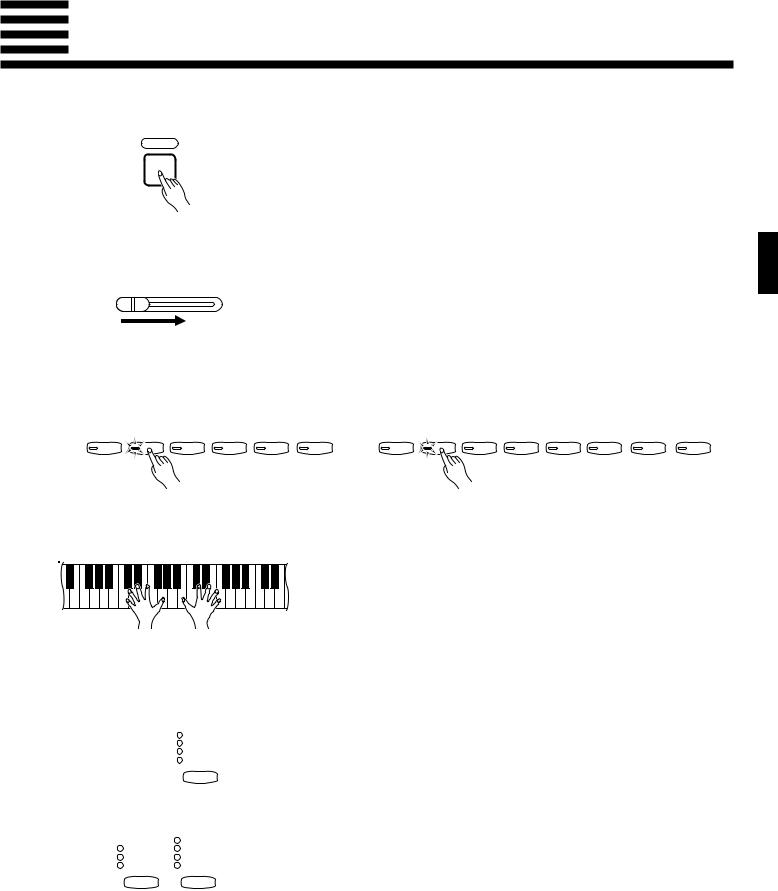
Selecting & Playing Voices
ZTurn Power On
POWER
After making sure that the Clavinova’s AC plug is properly inserted into a convenient AC wall outlet, press the [POWER] switch located to the left of the keyboard to turn the power ON.
When the power is turned ON, the [PIANO 1] voice selector LED will light (the PIANO 1 voice is automatically selected whenever the power is turned ON).
XSet the Volume
MASTER VOLUME
MIN 







 MAX
MAX
CSelect a Voice
Initially set the [MASTER VOLUME] control about half way between the “MIN” and “MAX” settings. Then, when you start playing, re-adjust the [MASTER VOLUME] control for the most comfortable listening level.
Select the desired voice by pressing one of the voice selectors.
CLP-154S |
|
CLP-155 |
|
CLAVINOVA |
HARPSI- |
CLAVINOVA |
HARPSI- |
PIANO 1 PIANO 2 TONE E. PIANO |
CHORD ORGAN |
PIANO 1 PIANO 2 TONE E. PIANO |
CHORD VIBES STRINGS ORGAN |
VPlay
BAdjust Tone & Add Effects
As Required
CLP-154S |
REVERB |
ROOM |
|
|
HALL 1 |
|
HALL 2 |
|
COSMIC |
CLP-155 |
|
BRILLIANCE |
REVERB |
|
ROOM |
MELLOW |
HALL 1 |
NORMAL |
HALL 2 |
BRIGHT |
COSMIC |
The Clavinova also offers keyboard touch response, so the volume and timbre of notes played can be controlled according to how “hard” you play the keys. The amount of variation available depends on the selected voice.
You can also change the overall tone or add reverb and/or effects as desired by using the [REVERB] button, and the [BRILLIANCE] button on the CLP-155 (see page 9 for [BRILLIANCE] button operation, “Reverb” on page 8).
5
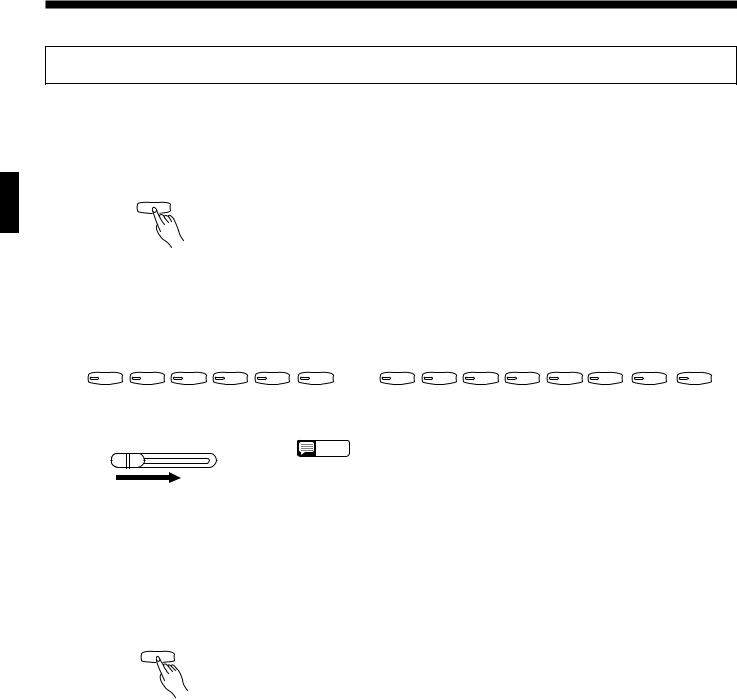
Selecting & Playing Voices
Playing the Demonstration Tunes
The CLP-154S features 6 demonstration tunes and the CLP-155 has 8 demo tunes that effectively demonstrate their sound capabilities. Here’s how you can select and play the demo tunes.
ZEngage the Demo Mode
DEMO
XSelect a Demo Tune
Press the [DEMO] button to engage the demo mode — the voice selectors will flash in sequence.
Press one of the flashing voice selectors to start playback of the corresponding demo tune — featuring the voice normally selected by that voice selector button. The demo tunes will play in sequence until stopped, starting with the selected tune. The voice selector indicator will flash during demo playback.
CLP-154S |
|
CLP-155 |
|
CLAVINOVA |
HARPSI- |
CLAVINOVA |
HARPSI- |
PIANO 1 PIANO 2 TONE E. PIANO |
CHORD ORGAN |
PIANO 1 PIANO 2 TONE E. PIANO |
CHORD VIBES STRINGS ORGAN |
CSet the Volume
MASTER VOLUME
MIN 







 MAX
MAX
VPlay a Different Demo
Use the [MASTER VOLUME] control to adjust the volume.
NOTE • The [TEMPO] control does not affect demo playback.
You can start playback of any other demo tune during playback by simply pressing the corresponding voice selector. Playback will stop and the playbackready mode described in step 2, above, will be re-engaged if you press the voice selector of the demo that is currently playing.
BStop the Demo
Press the [DEMO] button when you want to stop demo playback and return to the normal play mode.
DEMO
The Demo Tunes CLP-154S
[PIANO 1] button: Etude op. 10-5 “Black Keys” by F. F. Chopin [PIANO 2] button: “Le Rhône” by K. Hattori
[CLAVINOVA TONE] button: “Pavane pour une infante défunte” by M. J. Ravel
[HARPSICHORD] button: “Le Coucou” by L. C. Daquin
[ORGAN] button: “Jesu, Joy Of Man’s Desiring” (Chorale from Cantata No. 147) by J. S. Bach
•The demonstration pieces listed above are short excerpts from the original compositions. The other demo song is original (© 1994 by YAMAHA CORPORATION).
CLP-155
[PIANO 1] button: Etude op. 10-5 “Black Keys” by F. F. Chopin [PIANO 2] button: “Le Rhône” by K. Hattori
[CLAVINOVA TONE] button: “Pavane pour une infante défunte” by M. J. Ravel
[HARPSICHORD] button: “Le Coucou” by L. C. Daquin
[VIBES] button: “Schmetterling (Papilions)” op. 43 by E. H. Grieg [STRINGS] button: “Charmaine” by L. Polladk
[ORGAN] button: “Jesu, Joy Of Man’s Desiring” (Chorale from Cantata
No. 147) by J. S. Bach
•The demonstration pieces listed above are short excerpts from the original compositions. The other demo song is original (© 1994 by YAMAHA CORPORATION).
6
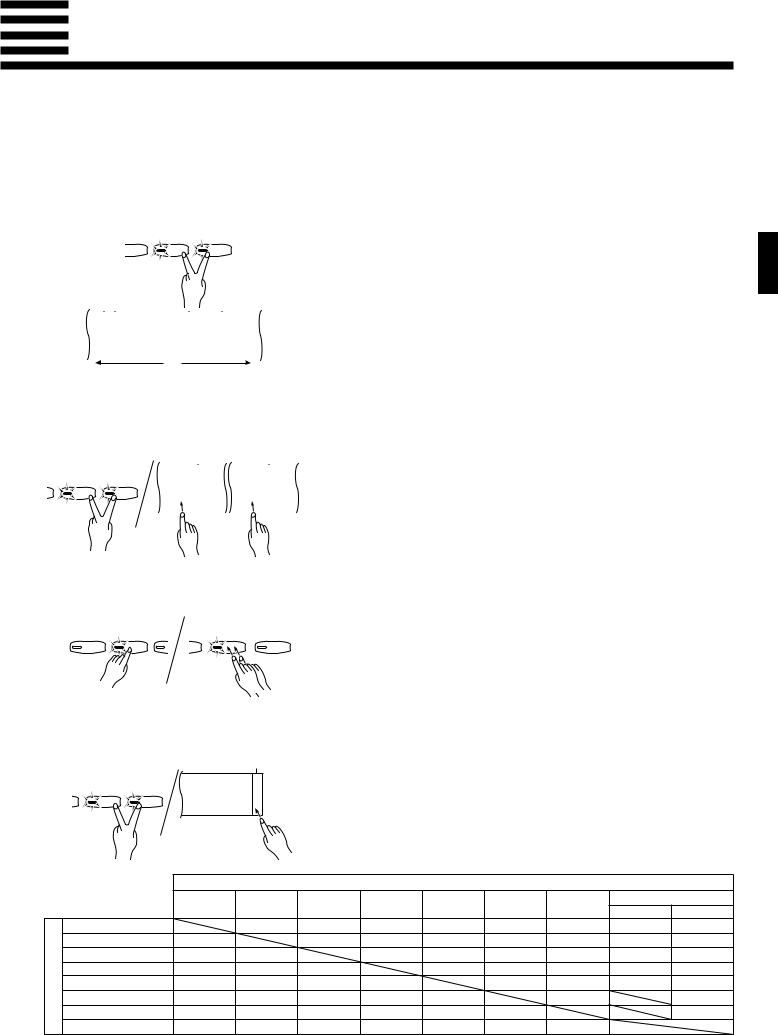
The Dual Mode
The DUAL mode makes it possible to play two voices simultaneously across the entire range of the keyboard. To activate the DUAL mode simply press two voice selectors at the same time (or press one voice selector while holding another). The voice indicators of both selected voices will light when the DUAL mode is active. To return to the normal single-voice play mode, press any single voice selector.
●Adjusting the Balance Between the Dual-mode Voices
VINOVA |
|
HARPSI- |
ONE |
E. PIANO |
CHORD |
C2 |
C3 |
C4 |
|
|
|
|
|
|
|
|
|
|
|
|
|
|
|
|
|
|
|
|
|
|
|
|
|
|
|
|
|
|
|
|
|
|
|
|
|
|
|
|
|
|
|
|
|
|
|
|
|
|
|
|
|
|
|
|
|
|
|
|
|
|
|
|
|
|
|
|
|
|
|
|
|
|
|
|
|
|
|
|
|
Left voice |
|
|
Equal |
|
Right voice |
|||||||||||||
|
maximum. |
|
|
balance. |
|
|
maximum. |
||||||||||||
●Shifting a Dual-Mode Voice Up One Octave
C1 |
C5 |
|
|
|
|
|
|
|
|
|
|
|
|
|
|
|
|
|
|
|
VA |
HARPSI- |
|
|
|
|
|
|
|
|
|
|
|
|
|
|
|
|
|
E. PIANO |
CHORD |
|
|
|
|
|
|
|
|
|
|
|
|
|
|
|
|
|
|
|
|
|
|
|
|
|
|
|
|
|
|
|
|
|
|
|
|
|
|
|
|
|
|
|
|
|
|
|
|
|
|
|
|
|
|
|
Left voice |
Right voice |
shift up. |
shift up. |
The volume levels of the two voices combined in the DUAL mode are normally set automatically to produce a pleasing balance (see “Default Settings” below). The balance can be adjusted manually by using the C2 through C4 keys on the keyboard while pressing the two voice selectors corresponding to the voices to be combined in the DUAL mode.
The C3 key produces equal (50:50) balance between the two voices, while keys to the left of C3 increase the volume of the left voice in relation to the right voice, and keys to the right of C3 increase the volume of the right voice in relation to the left voice. By “left” and “right” voice we refer to the relative positions of the voice selectors — i.e. in a PIANO 2/ CLAVINOVA TONE combination PIANO 2 is the left voice and CLAVINOVA TONE is the right voice.
Depending on which voices you combine using the DUAL mode, the combination may sound better if one of the voices is shifted up an octave. To shift the right voice, press the C5 key while pressing the two voice selectors corresponding to the voices to be combined in the DUAL mode. Press C5 again to shift the voice back to its normal range. Use the C1 key in the same way to shift the left voice.
Default octave settings are provided for all voice combinations, as listed in the “Default Settings” chart, below.
● Slow-attack Strings (CLP-155 only)
PIANO 1 PIANO 2 |
CLAV |
|
|
|
TO |
S |
STRINGS |
ORGAN |
In a DUAL mode voice combination using STRINGS and any other voice, it is possible to switch the STRINGS voice to a slow-attack variation when initially selecting the voices by pressing the [STRINGS] selector twice while holding the other voice selector. Repeat this operation to return to the normal STRINGS voice attack.
●Memorizing the Balance, Strings Type (CLP-155), &
Octave Shift Settings
C7
VA |
HARPSI- |
|
|
|
|
|
|
E. PIANO |
CHORD |
|
|
|
|
|
|
|
|
|
|
|
|
|
|
|
|
|
|
|
|
|
|
Press the C7 key while holding any two voice selectors to memorize all balance, STRINGS voice attack variation (CLP-155), and octave shift settings made since the power was turned on. The memorized settings will be retained in memory for about one week after the power is turned off, then the default settings will be restored. To keep the memorized settings for longer periods, turn the power on briefly at least once a week.
If these settings are not memorized as described above, they are retained in memory only until the Clavinova is turned off.
Default Settings |
|
|
|
|
Balance |
|
|
|
|
|
|
|
PIANO 1 |
PIANO 2 |
CLAVINOVA |
E. PIANO |
HARPSI- |
VIBES |
STRINGS |
ORGAN |
|
|
|
TONE |
CHORD |
(CLP-155) |
(CLP-155) |
(CLP-154S) |
(CLP-155) |
|||
|
|
|
|
|
||||||
|
PIANO 1 |
|
C3 |
C3 |
C3 |
C3 |
C3 |
F2 |
F2 |
E2 |
Octave |
PIANO 2 |
0 |
|
C3 |
C3 |
C3 |
C3 |
F2 |
F2 |
E2 |
CLAVINOVA TONE |
0 |
0 |
|
C3 |
C3 |
C3 |
F2 |
F2 |
F2 |
|
|
|
|||||||||
|
E. PIANO |
0 |
0 |
0 |
|
C3 |
C3 |
F2 |
F2 |
E2 |
Shift |
HARPSICHORD |
0 |
0 |
0 |
0 |
|
C3 |
F2 |
G2 |
G2 |
VIBES (CLP-155) |
R |
R |
R |
R |
R |
|
B2 |
|
B2 |
|
|
|
|
||||||||
|
STRINGS (CLP-155) |
0 |
0 |
0 |
0 |
0 |
L |
|
|
C3 |
|
ORGAN |
0 |
0 |
0 |
0 |
0 |
L |
0 |
|
|
C2 … C4: Balance keys |
0: Normal octave L: Left voice up one octave |
R: Right voice up one octave |
7
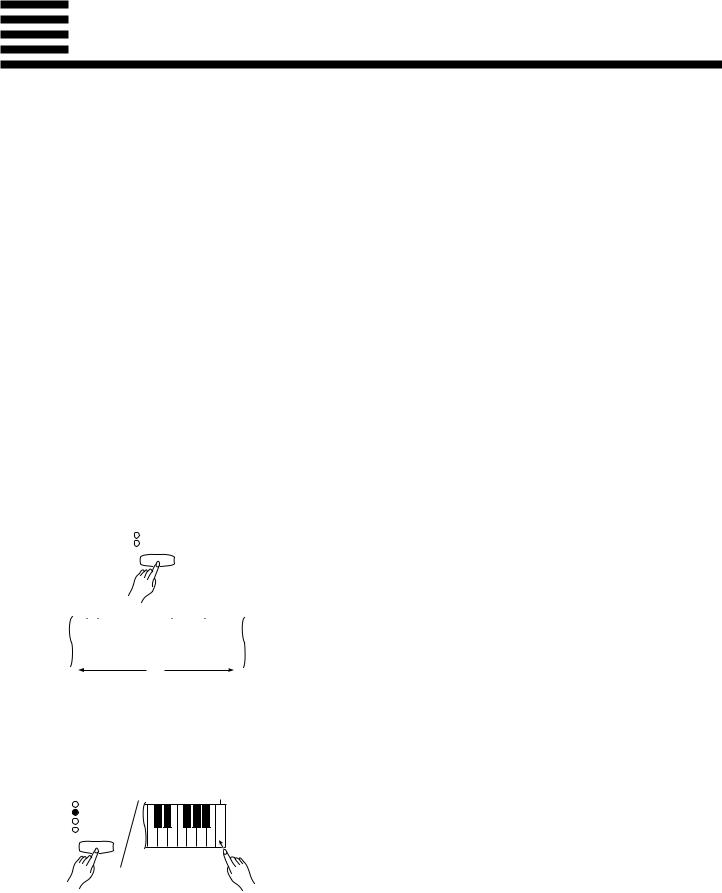
Reverb
The [REVERB] button selects a number of digital reverb effects that you can use for extra depth and expressive power.
To select a reverb type press the [REVERB] button a few times until the indicator corresponding to the desired type lights (the indicators light in sequence each time the [REVERB] button is pressed). No reverb is produced when all indicators are off.
|
OFF ............ |
When no reverb effect is selected (no REVERB indicator is lit), a special natural |
|
|
damper effect is applied to the piano voices. This simulates the natural resonance of |
|
|
|
|
|
an acoustic piano’s strings and sound board when the damper pedal is pressed. |
|
ROOM ........ |
This setting add a continuous reverb effect to the sound that is similar to the type of |
|
HALL 1 |
acoustic reverberation you would hear in a medium-size room. |
|
||
|
For a “bigger” reverb sound, use the HALL 1 setting. This effect simulates the natu- |
|
|
|
ral reverberation of a medium-size concert hall. |
|
HALL 2 ...... |
For a really spacious reverb sound, use the HALL 2 setting. This effect simulates the |
|
|
natural reverberation of a large concert hall. |
|
COSMIC .... |
The COSMIC reverb effect produces an echo-plus-reverb sound that can add life and |
|
|
animation to your music. |
● Adjusting Reverb Depth
REVERB
 ROOM
ROOM
 HALL 1
HALL 1
HALL 2
COSMIC
C2 |
C3 |
C4 |
The depth of the selected reverb effect can be adjusted for the current voice by using the C2 through C4 keys on the keyboard while holding the [REVERB] button. The C3 key sets the “normal” depth for the selected effect. Keys to the left of C3 decrease the reverb depth, while keys to the right of the C3 key increase the reverb depth. Separate reverb settings can be made for each effect and voice, and these settings are retained in memory until the power is turned off. The depth of the natural damper effect is fixed.
|
|
|
|
|
|
|
|
|
|
|
|
|
|
|
|
|
|
|
|
|
Default Settings |
|
|
|
|
|
|
|
|
|
|
|
|
|
|
|
|
|
|
|
|
|
|
|
|
|
|
|
|
|
|
|
|
|
|
|
|
|
|
|
|
|
|
|
|
|
|
|
|
|
|
|
|
|
|
|
|
|
|
|
|
|
|
|
|
|
|
|
|
|
|
|
|
|
|
|
|
|
|
|
|
|
ROOM |
|
HALL 1 |
HALL 2 |
COSMIC |
|
|
|
|
|
|
|
|
|
|
|
|
|
|
|
|
|
|
|
|
|
|
|
||||
|
|
|
|
|
|
|
|
|
|
|
|
|
|
|
|
|
|
|
|
|
|
|
|
|
|
|
|
|
|
|
|
|
|
|
|
|
|
|
|
|
|
|
|
|
|
|
|
STRINGS (CLP-155), ORGAN |
C3 |
|
C3 |
F3 |
E3 |
|
|
|
|
|
|
|
|
|
|
|
|
|
|
|
|
|
|
|
|
|
|
|
|
|
|
|
|
Decrease |
|
Normal |
|
|
Increase |
* All effect types set to C3 for all other voices. |
|
|
|
||||||||||||||||
|
depth. |
|
depth. |
|
|
|
depth. |
|
|
|
|
|
|
|||||||||||||
* The default reverb type is ROOM.
●Memorizing the Reverb Type & Depth Settings
REVERB |
C7 |
ROOM |
|
HALL 1 |
|
HALL 2 |
|
COSMIC |
|
Press the C7 key while holding the [REVERB] button to memorize the current effect type and all depth settings made since the power was turned on. The memorized settings will be retained in memory for about one week after the power is turned off, then the default settings will be restored. To keep the memorized settings for longer periods, turn the power on briefly at least once a week.
If these settings are not memorized as described above, they are retained in memory only until the Clavinova is turned off.
8
